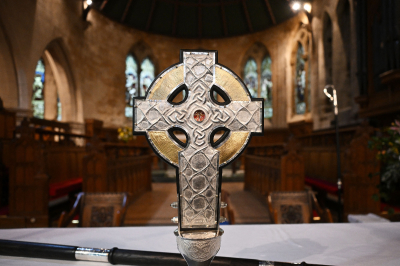10 heretical views regarding Jesus

Having a biblical view of Jesus during this Christmas season is essential. Unfortunately, many people in Christianity have erroneous concepts: some think He was a created being, some think that He was just a good teacher, some think that He was fully divine and not human, and some believe He was fully human and not God.
Jesus asked the disciples, “Who do men say that I am?” (Matthew 16:13-17). It was important to Him that men correctly understood who He was. To know precisely meant a blessing, and not to know indicated you could not be blessed by Father God.
The great doctors of the early church who fought erroneous views regarding Jesus made the correct belief of who Christ was of primary importance:
The beginning of the text of the Athanasian Creed is as follows:
“Whosoever will be saved, before all things it is necessary that he hold the Catholic faith. Which faith unless every one do keep whole and undefiled, without doubt he shall perish everlastingly. And the Catholic faith is this: that we worship one God in Trinity, and Trinity in Unity; neither confounding the Persons, nor dividing the Essence.”
Also, the first three post-apostolic ecumenical councils aimed to grant believers the proper views regarding Jesus so they could be distinguished from heretical beliefs.
(By heresy, we refer to a belief or opinion profoundly at odds with established doctrine, especially in a religious context, leading to denial of orthodox tenets. Regarding this, Jude 3 admonishes us to earnestly contend for the faith that was once for all delivered to the Saints.)
- Nicene Creed (325 AD): Formulated at the First Council of Nicaea, this creed was designed to establish an explicit doctrine of the nature of Christ in response to Arianism. It affirmed the full divinity of Jesus, stating that He is “of the same substance” (homoousios) as the Father. This creed was pivotal in defining the orthodox understanding of the Trinity and Christ’s divine nature.
- Constantinopolitan Creed (381 AD): Expanded at the First Council of Constantinople, this creed refined the Nicene Creed. It further clarified the nature of the Holy Spirit, affirming His divinity and co-equal status with the Father and the Son within the Holy Trinity. It also addressed various heretical views that emerged after Nicaea, strengthening the Church’s stance on the Trinity and the full divinity and humanity of Jesus.
- Chalcedonian Creed (451 AD): Formed at the Council of Chalcedon, this creed addressed the controversies of Nestorianism and Monophysitism. It defined Christ as having two distinct natures, divine and human, united in one person “without confusion, without change, without division, without separation.” This creed aimed to balance the understanding of Jesus’ dual nature, emphasizing that neither nature was diminished by the other.
Consequently, Christians should know these councils since history repeats itself, and many of the same heresies are popping up again in the modern-day church.
The following are ten heretical views regarding Jesus:
1. Arianism: Arianism, named after Arius, a priest in Alexandria, held that Jesus Christ was created by the Father and thus was not co-eternal or of the same substance as God. This belief challenged the concept of the Holy Trinity by asserting that Jesus was subordinate to God the Father. (Modern-day Jehovah’s Witnesses, under the name, “Watchtower”, are a modern-day version of this heretical view.)
2. Docetism: Docetism, from the Greek “dokein,” meaning “to seem,” claimed that Jesus only seemed to have a human body and suffer on the cross. This view denied the true humanity of Jesus, suggesting that his physical form and sufferings were mere illusions. (This was a form of Gnosticism.)
3. Gnosticism: Gnosticism was a diverse set of beliefs; some posited that Jesus was a divine being who came to impart secret knowledge (gnosis) necessary for salvation. This belief often denied the humanity of Jesus, viewing the material world as inherently evil or imaginary.
4. Nestorianism: Nestorianism, associated with Nestorius, Archbishop of Constantinople, emphasized the disunion between the human and divine natures of Jesus Christ. It suggested that there were two separate persons in Jesus, one divine and one human, rather than two natures united in one person.
5. Monophysitism: Monophysitism, from the Greek “monos” (single) and “physis” (nature), held that Jesus had only one divine nature rather than both divine and human natures. This belief was a reaction against Nestorianism and was seen as undermining the full humanity of Jesus. In this view, the divinity of Christ totally subsumed the human aspect of Jesus, thus diminishing the incarnation
6. Marcionism: Founded by Marcion of Sinope, this belief system rejected the Old Testament and viewed the God of the Hebrew Bible as inferior to that of the New Testament. Marcionism posited that Jesus was the son of the New Testament God, entirely distinct from the Yahweh of the Old Testament and contemporary times. Christians who neglect the Old Testament because they think the New Testament reveals the love of God better than the First Testament have an adopted form of Marcionism.
7. Adoptionism: Adoptionism was the belief that Jesus was born as a mere man and was adopted as the Son of God at his baptism, resurrection, or ascension. This view contradicted the orthodox belief in the pre-existence of Christ and his divine nature from birth.
8. Apollinarianism: Proposed by Apollinaris of Laodicea, this doctrine held that Jesus had a human body and a human sensitive soul, but not a human rational mind, which was replaced by the divine Logos or Word. This view denied the full humanity of Jesus by asserting that his divine nature took the place of what would be the human mind, thus making him less than fully human.
9. Ebionitism: Ebionites were a Jewish Christian sect that viewed Jesus as a mere human and a prophet, but not divine. They rejected the concept of the Virgin Birth and insisted on the necessity of following Jewish law and rites. They saw Jesus as an inspired human messenger but not as God incarnate.
10. Patripassianism: Also known as Modalistic Monarchianism, this belief, held by figures like Sabellius, proposed that the Father, Son, and Holy Spirit are not distinct persons within the Godhead but somewhat different modes or aspects of God. Patripassianism suggested that the Father suffered on the cross as Jesus, thus denying the personal distinctions within the Trinity.
The modern-day “Jesus only” expressions of Pentecostalism are a contemporary version of this view.
Dr. Joseph Mattera is an internationally-known author, consultant, and theologian whose mission is to influence leaders who influence culture. He is the founding pastor of Resurrection Church, and leads several organizations, including The U.S. Coalition of Apostolic Leaders and Christ Covenant Coalition.
To order his books or to join the many thousands who subscribe to his newsletter, go to josephmattera.org



























